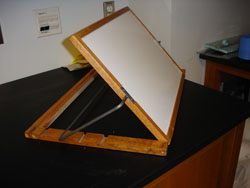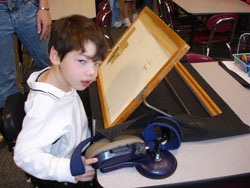Designers: Tommye Fitzpatrick, Jessica Son, Christine McMahon
Client Coordinator: Karen Hammers
Supervising Professors: Richard Goldberg, Kevin Caves
 INTRODUCTION
INTRODUCTION
The client is a five year-old boy with cerebral palsy. He has an unstable trunk and stiff arms that move best vertically at the elbow. He only has use of his left hand, which cannot comfortably grasp anything less than 1″ in diameter, and he is suspected to have cortical vision impairment. The Custom Easel has adjustable angles and a magnetic whiteboard. The angle of the easel work surface may be adjusted to the best angle for the client, depending on the activity. A modified paper cutter, modified glue bottle, book ledge, clothespin book clips, page-turning wand, and magnet clips help him more independently glue, cut, hold books and turn pages. The Custom Easel also accommodates his suspected visual impairment with a detachable magnifying device.
SUMMARY OF IMPACT
The client’s teaching assistant, Karen Hammers, stated, “This project is a huge step in achieving that independence for him at school. Now he’ll be able to work on many more of his tasks by himself. As he gets older, the easel will be able to adapt as his needs change.”
TECHNICAL DESCRIPTION
The Custom Easel (Figure 1) features a 13″ x 18.5″ magnetic white board work surface with a 3/4″ varnished oak frame. The 16″ x 23″ varnished oak easel base adjusts to four positions – from flat to almost 90°, with a reinforced stainless steel brace which folds flat for carrying. A black non-skid mat keeps it from moving while the easel is in use.
A sliding magnifier was developed from a commercially available 22″ x 2″ varnished wooden drawer slide. The magnifier slides over the top of the easel work surface and is held in place on top by two metal brackets. The male part of the drawer slide is raised 2.5″ above the work surface, thereby magnifying the book or paper underneath without distorting the letters. Pegs on the male and female pieces of the slide allow the client to slide the magnifying sheet all the way to the left edge of the easel work surface so that he can turn book pages, but simultaneously keep the male piece from falling out of the female piece. A cutting device was modified from a FISKARS Ultrashape Xpress by shaving a rubber anti-skid pad down to fit around the blade, allowing the cutter blade to retract inside and not be exposed when the device is not in use. Two strips of magnetic tape attached to the bottom of the cutting device stabilize it against the magnetic white board. To hold paper in place while cutting, six sheet metal strips with magnetic tape attached to the back are supplied (two 2″, 7.5″, 10.25″, two 13″), to be placed around the edge of the paper.
A gluing device was modified from an Aleene’s Brush-On Tacky Glue bottle. The tacky glue is replaced with Elmer’s Washable School Glue. A rare earth magnet glued to the bottom of the glue bottle helps it stick to the magnetic white board work surface. A modified plastic salsa bowl fits like a skirt around the glue bottle, stabilizing it while in use. A 1.5″ tall foam roller, attached to an oak disk, is screwed into the top of the glue bottle so that the client can hold the glue brush easier and more comfortably.
To facilitate page-turning, a wand was created by gluing a 3/4″ diameter round magnet and metal ring onto the end of a 4.5″ long, 1″ diameter wooden dowel. 3/4″ diameter magnets were also glued on plastic Acco™ Hot Clips, one magnet per clip, which are placed on the edge of each page of a book for the client to turn. The clip magnets are not strong enough to stick to each other, but they are strong enough to stick to the magnet wand. Plastic magnet clips are used rather than metal paperclips because they give an added weight to the page, ensuring that once the client turns the page, the page will not flip back, frustrating the client.
 Two rare earth magnets are placed on the back of a wooden ledge for a book to sit on, and five magnets are placed on the backs of two 6″ long clothespins that hold either side of the book open. To make transporting the easel and all of its accessories around during the school day easy, a 23″ x 27″ durable nylon ArtBin Tote Folio is provided. The main pocket of the folio is lined with cotton batting to protect the easel in case the folio is dropped or falls. Since the client’s aide needs both hands free to push his wheelchair from classroom to classroom, the folio can either be worn slung over the shoulder using its shoulder strap, or it can hang on the back of the client’s electric wheelchair.
Two rare earth magnets are placed on the back of a wooden ledge for a book to sit on, and five magnets are placed on the backs of two 6″ long clothespins that hold either side of the book open. To make transporting the easel and all of its accessories around during the school day easy, a 23″ x 27″ durable nylon ArtBin Tote Folio is provided. The main pocket of the folio is lined with cotton batting to protect the easel in case the folio is dropped or falls. Since the client’s aide needs both hands free to push his wheelchair from classroom to classroom, the folio can either be worn slung over the shoulder using its shoulder strap, or it can hang on the back of the client’s electric wheelchair.
Figure 2 shows the client using the easel. Cost of parts was approximately $260.